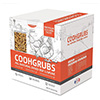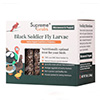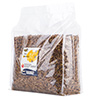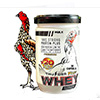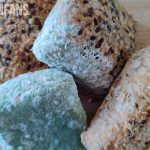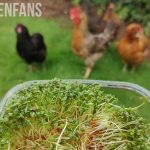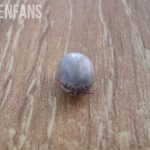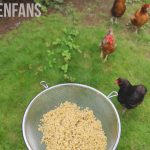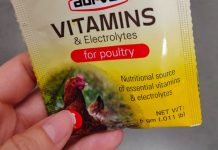Proteins for Chickens: Best Sources, Dose, Molt, Risks (2024)
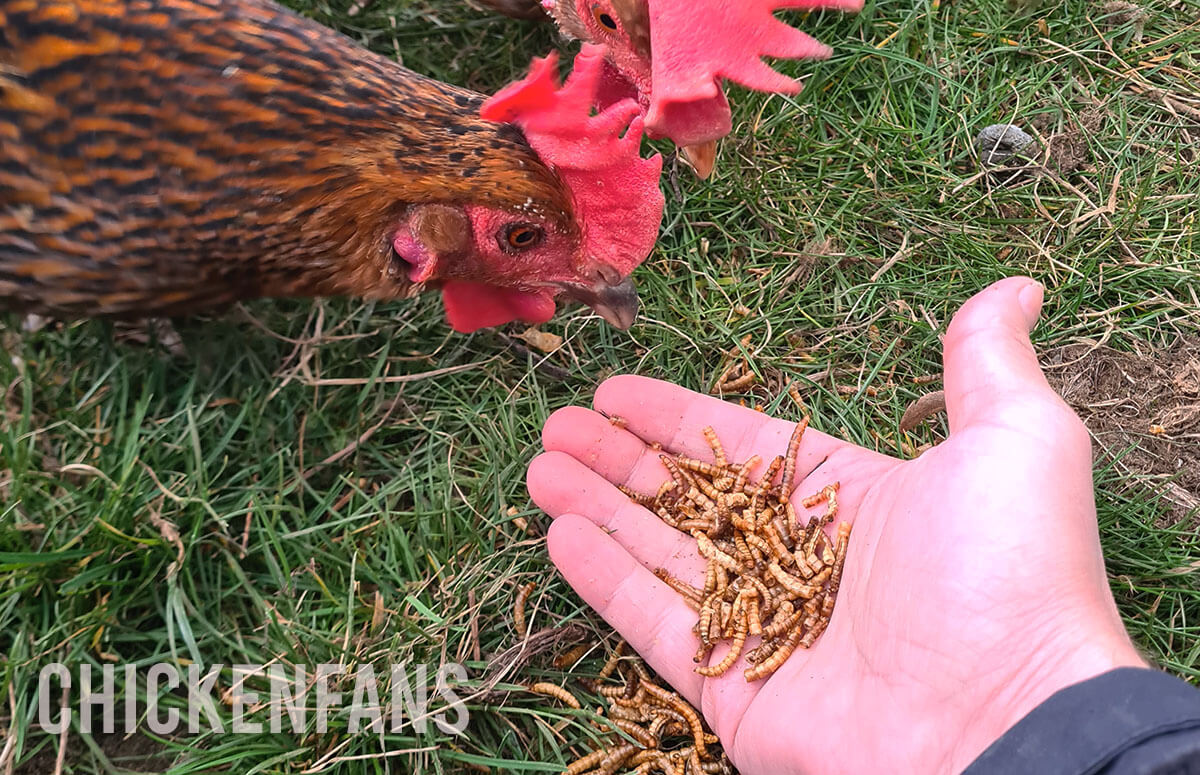

Proteins are crucial for a chicken’s health, growth, feather development, and overall well-being. A chicken’s body is 65-70% water and 20-35% protein. These proteins are made up of amino acids, the building blocks of their life.
We discuss how much protein chickens need, what good and bad protein sources are, and we look at the most important amino acids for chickens. We also discuss the protein needs during molt, what protein supplements you can use, and the risks of excessive protein supplementation.
- Protein is an essential part of a chicken’s diet
- Chicks need more protein to grow
- Chickens need more protein when molting
- Methionine is the most important amino acid
- Mealworms & Black Soldier Fly Larvae are excellent insect-based protein sources
If you’re just here looking for the best protein supplements to support your flock, here is our top selection:
Why do Chickens Need Protein?
Chickens need proteins for several reasons:
- Growth & Development: proteins are essential building blocks of muscles, bones, and feathers. Proteins are vital for chicks to grow up.
- Egg laying: some proteins come in the form of hormones that are critical for reproduction. For example, the Follicle-stimulating hormone (FSH) plays a critical role in developing ovarian follicles in hens.
- Body Repair: proteins are necessary for the repair and development of a chicken’s body cells, tissue, and organs
- Immune System: some proteins form enzymes that are crucial in the processing of antigens, the buildup of immune cells, the production of antibodies, and inflammation responses
- Energy Source: proteins can be broken down by the digestive system and used for energy production, just like fats and carbohydrates in the chicken’s feed
A balanced diet enriched in proteins, particularly amino acids, is crucial for the growth, health, and overall well-being of chickens. Without adequate protein intake, chickens may suffer from stunted growth, poor egg-laying, diseases, and other health issues.
Many people eat eggs and chicken meat because they are a rich source of protein.
How Much Protein do Chickens Need?
How much protein chickens need depends on their age and physiological stage:
- Age: chicks need more protein for their growth and to develop muscles. Full-grown adult chickens only need protein for maintenance purposes.
- Egg-Layers: Egg-laying hens need proteins to form egg whites, which are mainly made of proteins. Meat chickens primarily need proteins for growth and to build muscle.
This table shows how much protein chickens need daily:
| Type | Stage | Age | Protein |
|---|---|---|---|
| Egg-layer | Chick | 1-4 | 20% |
| Egg-layer | Growing | 5-10 | 19% |
| Egg-layer | Before Lay | 11-16 | 16% |
| Egg-layer | Adult | >17 | 17-19% |
| Meat Chicken | Chick | 1-3 | 23-34% |
| Meat Chicken | Young | 3-6 | 20-21% |
| Meat Chicken | Adult | >6 | 18-19% |
| Rooster | Chick | 1-4 | 18-19% |
| Rooster | Growing | 5-16 | 15-16.5% |
| Rooster | Breeding | 23-65+ | 14-16% |
The problem with mainstream commercial chicken feed is that many only contain 15% protein. Since protein is so expensive, manufacturers only provide the bare minimum.
If you want to feed your chickens optimal protein levels, you either have to supplement them with extra protein or buy premium feed. Supplementation is especially important if they are free-range.
When do Chickens Need Extra Protein Supplements?
Protein is always an essential component of a chicken’s diet, but certain conditions demand extra protein supplementation:
- Molting: During molting, feathers shed, and new feathers develop, which requires a greater amount of protein [Gunawardana et al. in 2008].
- Disease: during illness, chickens eat less because their body suffers from stress and physiological changes. Providing high-density protein-rich foods with essential amino acids can restore balance and benefit the immune system by regulating the hormone flow.
- Heat Stress: chickens eat less during heat stress, which can impact egg-laying and health. Providing them with a protein-rich, low-calorie diet can improve their body mass and blood plasma, boosting their antioxidant levels and immune system. [Qaid and Al-Garadi, 2021; Attia and Hassan, 2017]
Protein Content in Chicken Feed and Treats
Plenty of foodstuffs can be given to boost protein supplementation. This table gives an overview of the protein content of common food sources.
| Food Source | Type | Protein Amount |
|---|---|---|
| Eggs | Animal-based | 11-12% |
| Live Mealworms | Insect | 18-22% |
| Dried Mealworms | Insect | 50-55% |
| Bugs | Insect | 10-25% |
| Lentils | Plant-based | 26% |
| Pumpkin seeds | Plant-based | 17-19% |
| Water beetle | Insect | 18-20% |
| Cricket | Insect | 12-15% |
| Grasshopper | Insect | 18-23% |
| Fish Meal | Plant-based | 55-60% |
| Canola Meal | Plant-based | 36% |
| Sunflower Meal | Plant-based | 28-32% |
| Black soldier fly | Insect | 50-55% |
However, not all proteins are created equally. They all come with their specific amino acid profiles. Some are more suitable for chickens than others.
Plant-Based Protein Sources in Chicken Feed
There are many sources of protein suitable for chicken feed. These proteins provide essential amino acids, the building blocks of proteins. However, protein sources all come with different amino acid profiles.
Sources of protein in chicken feed include:
- Soybean: the most common source in the US for poultry diets; producers are seeking alternative protein sources due to cost and availability. [soybean info center]
- Canola: a food-grade version of rapeseed oil that is low in erucic acid and, as such, a suitable replacement for soybean meal in poultry diets
- Field peas: contain 20-30% protein, but it’s a vegetable low in methionine, an essential amino acid for egg layers; can’t fully replace soybeans
- Flaxseed: a food supplement that’s used to enrich eggs with omega-3 fatty acids. Flaxseed contains 26% protein, but if you feed too much, the eggs start to taste weird.
- Sunflower seed: sunflower oil and whole seeds are high in protein but low in the amino acid lysine, essential for egg production and during molt; too many sunflower seeds yield pale yolks
- Lupins: contain up to 44% protein, but the amino acid profile is not suitable for poultry diets, and chickens need additional amino acid supplementation
Other sources include cottonseed meals, lentils, seaweed, alfalfa, and pulses.
Soybean in Chicken Feed
Soybean has always been the de facto standard for proteins in poultry. It contains more than 45% crude protein with all essential amino acids. On top of that, it also contains high levels of linoleic acid, a healthy omega-6 fatty acid.
Due to the high demand and the price, poultry farmers are looking for all kinds of alternatives to replace soybeans in chicken feed. Apart from the availability, there are also some health and safety concerns.
Glyphosate in GM soybeans
Over 90% of soy produced in the US has been genetically modified (GM) since 1996 to resist the glyphosate in Roundup, a widely used herbicide. Glyphosate is now banned in many countries and states because of its potential link to human cancer.
Over the years, weeds have developed resistance to Roundup, and farmers douse their crops multiple times a season to inhibit weed growth. Studies have now shown that glyphosate-tolerant GM soybeans contain high residues of glyphosate. [T. Bohn et al.]
Animal-Based Protein Sources in Chicken Feed (Vertebrates)
Plant-based protein sources are of commercial interest because they are cost-effective. However, many animal-based protein sources have more suitable amino acid profiles:
- Fish: high-quality protein source made from leftovers in the fishing industry; too much fish can result in odd-tasting eggs
- Feather Meal: decomposed feathers from slaughtered poultry contain about 80% of protein and are used as soybean replacement
- Meat: a high-quality protein source that comes with an excellent amino acid profile; processed waste meat of beef, pork, and poultry are used in feed
Insect-Based Protein Sources in Chicken Feed
Apart from animal by-products and plant-based protein sources, more and more researchers are looking at insects and worms.
Some common alternative insect protein sources are:
- mealworm: larvae of darkling beetles containing 18-22% of protein, 53-55% when dried
- black fly larvae: larvae of black flies containing 50-55% of protein
- house fly larvae: larvae of the common black/grey fly we all know
- grasshopper: grasshopper meal contains about 18-23% of protein
- locust: a subtype of short-horned grasshoppers
- cricket: cricket supplements contain about 12-15% of protein
The two most common types on the market are mealworms and black solder fly larvae.
Mealworms
Yellow mealworms are the larvae of darling beetles and are edible insects. Dried mealworms contain 50-55% crude protein. They contain all essential amino acids for chickens.
Whether they can replace soybean meal in chicken feed is still debated. Some studies show no negative effects, and others report increased growth performance. Incorporating mealworms at 5-10% of the diet is comparable to soybeans, but a 15% inclusion rate may negatively impact growth. [Hong et al., 2020; Selaledi et al.]
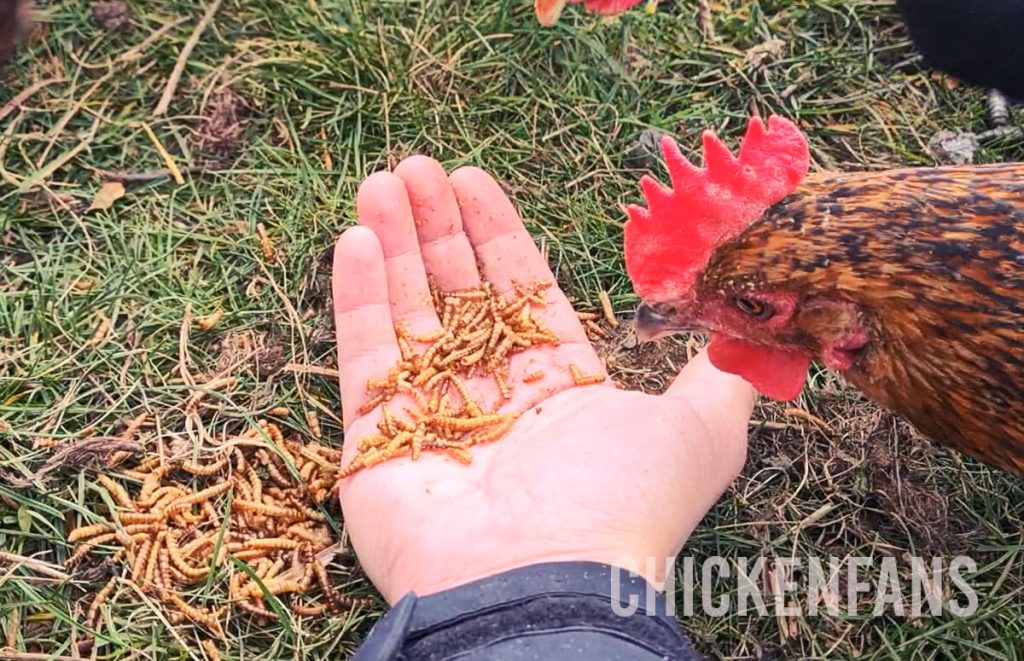
Mealworm-fed hens reportedly had juicy and soft flesh [Khan et al. 2018]. Additionally, adding mealworms to chickens’ diets enhances feed utilization effectiveness and growth rates [Hussain et al. 2017].
Black Soldier Fly Larvae
Due to its high protein content, defatted black soldier fly (BSF) is one of the most significant insect meals (Dabbou et al. 2018), making it an appropriate substitute for soybean meal as a source of protein (Nonigopal 2021). Chickens’ development, meat quality, overall health, and carcass yield were all enhanced by feeding BSF between 5 to 19 % (Schiavone et al. 2019).
Black Soldier Flies turn animal manure into high-quality, protein- and fat-rich products that may be utilized as an alternative protein source in poultry diets for use in animal feed (Veldkamp et al. 2012). The larvae also contain antimicrobial (Müller et al. 2017) peptides.
In general, Black Soldier Flies can be used as a partial or full substitute for traditional protein sources like fish and soybean meal in chicken food (Ahmed et al., 2023).
Plant-based vs. Meat-Based vs. Insects
Although all proteins found in plants, animals, and insects comprise amino acids, the key difference lies in their amino acid profiles.
Animal and insect proteins are well-balanced and contain all the essential amino acids. Plants lack some types of amino acids and have lower concentrations. On the other hand, plants are rich in fiber, minerals, and antioxidants.
| Protein Source | Plant | Meat | Insect |
|---|---|---|---|
| Amino Acid Profile | fewer essential amino acids * | well-balanced | well-balanced |
| Variability | consistent | consistent | depends on the life stage and substrate |
| Price | affordable | expensive | affordable |
Only soy protein powder is considered to be complete. It contains the highest protein content, particularly rich in essential amino acid profiles necessary for chickens.
While protein content is consistent in meat and plants, it can vary greatly in insects. Insect protein contents differ based on the substrate on which they were grown and the life stage of the insect. The protein composition of an adult fly differs from that of its larvae.
Protein Need for Chickens During Molt
When molting, chickens shed their old feathers and replace them with new ones. During this process, their body loses body fat and bone density, and their immune system may weaken, but their protein metabolism increases.
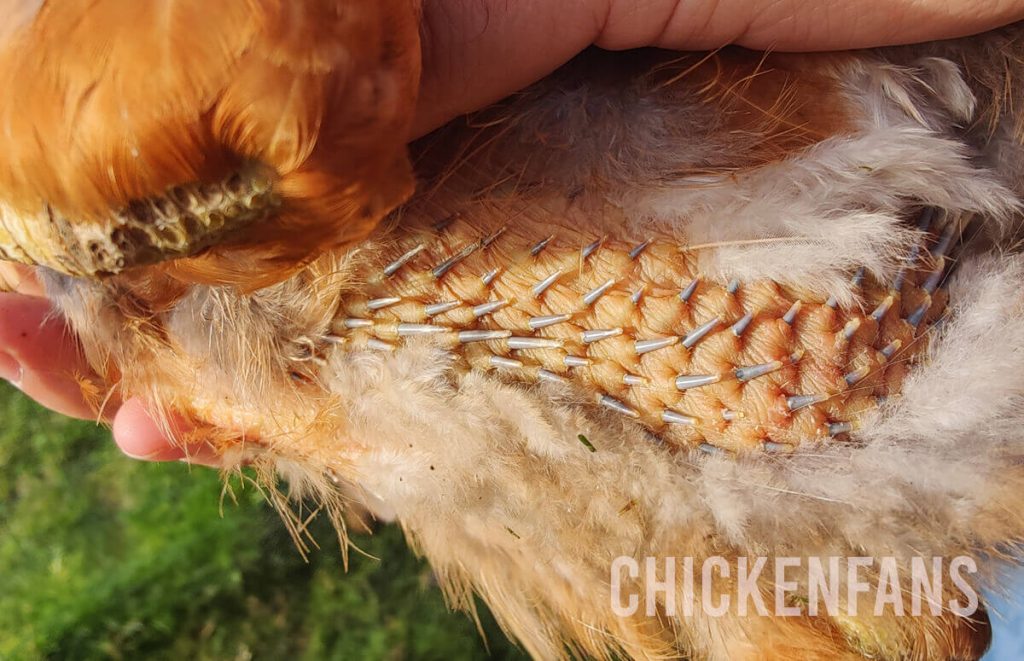
Protein is crucial for chickens during molt. It is as crucial for chickens during pre- and post-molt phases as it is for chicks in their growth spurt. [Anwar et al. 2012]
What about the Eggs
Multiple studies have shown that extra protein supplements, especially essential amino acids, can improve egg laying and reduce the negative effects of molting. Increasing protein improves egg quality and yield.
Of all amino acids, methionine is the most essential during molt. Yet, many layer diets typically lack methionine. Next to methionine, lysine is also crucial during molt. Chickens with extra L-carnitine in their diet, a derivative of lysine and methionine, have significantly heavier eggs. [Bunchasak and Silapasorn, 2005; Arslan 2006].
Whey and BCAA Supplements for Chickens
If you’ve ever hit the gym, you’ve seen shelves filled with Whey and BCAA protein supplements.
BCAA supplements are Branched-chain amino acids and contain three amino acids essential for humans: leucine, isoleucine, and valine. Although they are essential amino acids, none of these are of limiting amino acids for meat chickens.
BCAA supplementation is described in the literature for egg-laying hens that are on very low-protein diets and suffering from malnutrition. This is especially important for chicks from day 1 to 21 after hatch.
Whey protein powder contains more BCAAs than plant-based powders as it’s a pure protein derived from milk after curdling. Compared to soy, meat, and wheat, whey protein has larger amounts of BCAAs [Gangurde et al. 2011].
Most Important Amino Acids for Chickens
For humans, there are nine essential amino acids that we must get through our diet. These are histidine, isoleucine, leucine, lysine, methionine, phenylalanine, threonine, tryptophan, and valine. Our body can make all the other nonessential amino acids.
For poultry, ten amino acids must be provided in the diet for maximum performance: the same nine as we need, plus arginine.
Lysine and methionine are the most important amino acids, while threonine is the third limiting amino acid. Cysteine and tyrosine are recognized as semi-essential amino acids. Glycine and serine are the non-essential limiting amino acids in the poultry diet.
Methionine
Methionine is an essential amino acid for poultry growth and is involved in muscle building, feather synthesis, and protein synthesis. It plays a key role in DNA methylation, a biochemical process that happens billions of times in every cell of the chicken’s body to regulate gene expressions.
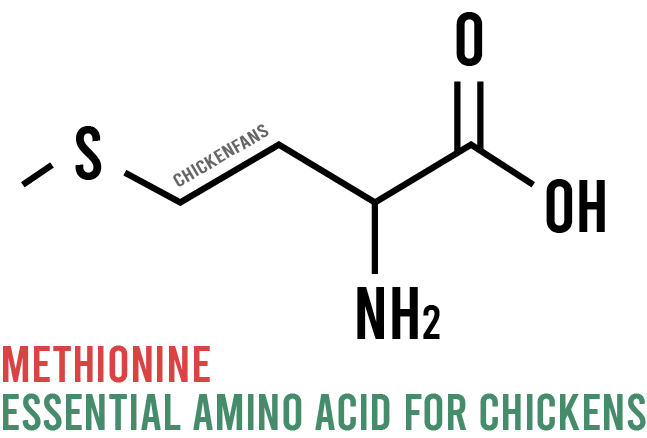
Adequate levels of methionine are important for optimal growth performance and to reduce abdominal fat in meat chickens. Methionine is one of the four sulfur amino acids that can help alleviate the adverse effects of heat stress and high temperatures (the other ones are cysteine, homocysteine, and taurine).
Methionine is also crucial for feather synthesis during molt. Chicken feathers mainly consist of keratin, a fibrous protein that is strong, flexible, and durable. Methionine is an important component of keratin and is essential for forming chemical disulfide bonds that strengthen the feather’s shaft.
Lysine
Lysine is an essential amino acid that is important for the growth, repair, and maintenance of body tissues and the absorption of calcium, which is essential for bone health and egg laying.
Increasing lysine supplementation, along with methionine, boosts growth, especially in young roosters.
Dietary supplementation of digestible lysine and threonine does not seem to influence the performance and egg quality of laying hens.
Threonine
Threonine is an important amino acid that helps build proteins in the body. It plays a significant role in gut health and protects it from harmful pathogens.
It also plays a role in the formation of uric acid. Chickens don’t pee with urine streams, and they have no bladder. Their kidneys produce urine with uric acid, which leaves the body with droppings. If you’re interested in how that works, we’ve dedicated a full article to that.
Risks of Excessive Protein Supplementation
Although protein is an essential part of a chicken’s diet, excessive intake can be dangerous.
Too much protein supplementation in chicken diets can lead to weight gain, kidney problems, and intestinal abnormalities. These can cause infectious diarrhea and provoke several other diseases.
Chickens that get a lot of proteins also drink much more. This can cause wet litter problems, opening the door to diseases.
Effect on the Chicken’s Body
When chickens eat too many proteins, their body can’t absorb the abundance of incoming amino acids. As a result, the excesses must be catabolized, which produces ammonia as a harmful by-product.
The chicken’s kidneys convert this ammonia waste to uric acid, which is basically the chicken’s pee that leaves the body via droppings.
This process negatively impacts the chicken’s metabolic homeostasis, can lead to various health issues, and increases the risk of epidemics of clinical necrotic enteritis caused by C. perfringens.
Protein Supplementation in Case of Disease
When a chicken gets sick, it eats less while its body undergoes physiological changes. Feeding a protein-enriched, high-density supplement with essential amino acids can help fulfill the body’s increased needs during illness.
In case of outbreaks, it can be beneficial to boost dietary protein intake or, at the very least, keep it within suggested levels. Protein regulates hormones such as insulin and glucagon that impact the immune system and enhance its ability to combat illness.
However, more protein is not always the way to go. In some cases, an increased protein diet can worsen the progression of certain diseases, such as necrotic enteritis, in chickens. Excessive protein leads to more ammonia that has to be excreted by the kidneys.
Protein Supplements for Chickens – Analysis
There are many supplements on the market. We’ll go a little deeper into what you can get and discuss based on the current state of research.
First, here are the over-the-counter supplements we selected:
We’ll start with the most common one: dried mealworms.
Mealworms
Dried mealworms come with 50-55% of protein, which is great. It’s also insect-based and comes with a proper amino acid profile.
Mealworms can serve as a supplement or a special reward for the flock during times when they could benefit from an additional boost.
Although they are an excellent protein source, the Black Soldier Fly is even better since it contains several other healthy micronutrients that mealworms lack.
Another question is whether mealworms can replace soybean meal in a chicken’s diet.
Different researchers have different points of view regarding mealworm larvae (MWL) as replacements for soybeans. In the research, MWL had either no impact on broiler chickens’ development rate and meat quality or increased growth performance without showing any detrimental impacts on blood profiles and carcass traits (Hong et al., 2020).
Selaledi et al. (2022) stated that incorporation levels of 5 and 10 % of MWL produced outcomes comparable to those fed the soya bean. The later authors also stated that increasing the doses of MWL as high as 15% can negatively impact growth efficiency.
Mealworm-fed hens reportedly had juicy and soft flesh (Khan et al. 2018). Additionally, adding MWL to the diet of chicken enhances feed utilization effectiveness and specific growth rate (Hussain et al. 2017).
Supreme Grubs Natural Black Soldier Fly Larvae for Chickens
Apart from meat, the black soldier fly is one of the best protein sources you can give your flock.
Due to its high protein content, defatted black soldier fly (BSF) is one of the most significant insect meals (Dabbou et al. 2018), making it an appropriate substitute for soybean meal as a source of protein (Nonigopal 2021). Chickens’ development, meat quality, overall health, and carcass yield were all enhanced by feeding BSF between 5 to 19 % (Schiavone et al. 2019).
It turns animal manure into high-quality, protein- and fat-rich products that may be utilized as an alternative protein source in poultry diets for use in animal feed (Veldkamp et al. 2012). On top of the protein content, the BSF larvae also contain antimicrobial (Müller et al. 2017) peptides. BSF can be used as a partial or full substitute for traditional protein sources like fish and soybean meal in chicken food (Ahmed et al. 2023).
The amino acid profile is comparable to that of mealworms and covers all essential proteins. The black soldier fly supplements seem to be slightly richer in Methionine, the most prominent amino acid for chickens, but it’s a very close call. BSF supplements are also higher in calcium-content, so they are suitability for laying chickens.
Thunder Whey
Whey protein supplements are extremely popular in the gym. What can they do for chickens?
Whey is a protein product obtained from milk after removing other ingredients, and the powder contains about 80% protein. It’s rich in all essential and Branched-chain amino acids (BCAAs), which are vital for the chicken’s body. It directly heals muscles and helps in muscle development.
Thunder Whey supplement contains whey and BCAA’s (valine, isoleucine, and leucine), which are vital for the body. The label on Thunder Whey displays valine, isoleucine, and leucine separately, but based on the weight, we assume there are probably no extra BCAAs in the box other than what’s in the whey.
Although BCAA’s are essential amino acids, none are primarily limiting amino acids for chickens. Most of the value probably comes from the methionine and lysine in the whey rather than the BCAA’s.
The supplement also contains calcium carbonate, which makes it interesting for egg-laying hens during the molt.
The product is commercialized for game fowl but can be used as an all-purpose protein supplement. It’s probably appealing to people because they recognize whey and BCAA supplements from bodybuilding.
Although whey contains traces of lactose, this supplement can be added to the chicken’s diet without any problem. It’s generally accepted that whey can be added to a broiler chicken diet as long as unlimited access to water is provided. Whey may also be served as a drink if combined with 1.8 times its weight in water. (Shariatmadari and Forbes 2005; Pineda-Quiroga et al. 2018; Ashour et al. 2019; Greenhalgh et al. 2022)
Whey is a premium supplement for humans as well as chickens. However, your flock will probably not get as crazy for whey as they do for mealworms or dried flies.
Frequently Asked Questions
Here are some common questions regarding protein supplementation.
Calcium and protein are both important for laying chickens, but protein is more important during the molting phase, and calcium is more important during the laying phase. Protein is also crucial in the pre- and post-molting phases.
Soybean meal is an excellent nutrient-dense source of protein with an excellent amino acid profile suitable for poultry. However, studies have shown that GM soybeans contain glyphosate residues, so more and more people are searching for organic soy or alternative protein sources.
General-purpose protein supplements like whey can be fed to chickens, but chickens have different amino acid needs than humans. Chickens need protein sources high in Methionine and Lysine. Supplements like BCAA’s don’t bring much to the poultry table.

Dr. Ibrar A. is a licensed veterinarian with many years of experience on poultry farms and poultry feed. He has published several scientific articles on poultry diets, amino acids, and prebiotic usage in poultry. Dr. Ibrar is currently pursuing a Ph.D. in animal nutrition and nutritional diseases.
References
- Ahmed I, İnal F, Riaz R, Ahsan U, Kuter E, Ali U. 2023. A review of black soldier fly (2023) as a potential alternative protein source in broiler diets. Annals of Animal Science.
- Anwar H, Rahman Z, Javed I, Muhammad F. 2012. Immunohistochemical localization and morphometry of somatotrophs and lactotrophs in protein, probiotic and symbiotic supplemented molted layers. European Journal of Histochemistry: EJH. 56(3).
- Arslan C. 2006. L-Carnitine and its use as a feed additive in poultry feeding: a review. Revue Medicine Veterinaire. 157:134-142.
- Ashour EA, Abd El-Hack ME, Alagawany M, Swelum AA, Osman AO, Saadeldin IM, Abdel-Hamid M, Hussein E-SO. 2019. Use of whey protein concentrates in broiler diets. Journal of Applied Poultry Research. 28(4):1078-1088.
- Attia YA, Hassan SS. 2017. Broiler tolerance to heat stress at various dietary protein/energy levels. Europ Poult Sci. 81(10.1399).
- Bunchasak C, Silapasorn T. 2005. Effects of adding methionine in low-protein diet on production performance, reproductive organs and chemical liver composition of laying hens under tropical conditions. International Journal of Poultry Science. 4(5):301-308.
- Dabbou S, Gai F, Biasato I, Capucchio MT, Biasibetti E, Dezzutto D, Meneguz M, Plachà I, Gasco L, Schiavone A. 2018. Black soldier fly defatted meal as a dietary protein source for broiler chickens: Effects on growth performance, blood traits, gut morphology and histological features. Journal of animal science and biotechnology. 9:1-10.
- Domingues CdF, Sgavioli S, Praes MFFM, Duarte KF, Castiblanco DMC, Santos E, Alva JCR, Junqueira OM. 2012. Lysine and methionine+ cystine for laying hens during the post-molting phase. Brazilian Journal of Poultry Science. 14:187-192.
- Drew M, Syed N, Goldade B, Laarveld B, Van Kessel A. 2004. Effects of dietary protein source and level on intestinal populations of Clostridium perfringens in broiler chickens. Poultry science. 83(3):414-420.
- Forbes J, Shariatmadari F. 1994. Diet selection for protein by poultry. World’s Poultry Science Journal. 50(1):7-24.
- Gangurde H, Chordiya M, Patil P, Baste N. 2011. Whey protein. Scholars’ Research Journal. 1(2).
- Greenhalgh S, Lemme A, de Paula Dorigam JC, Chrystal PV, Macelline SP, Liu SY, Selle PH. 2022. Dietary crude protein concentrations, feed grains, and whey protein interactively influence apparent digestibility coefficients of amino acids, protein, starch, and performance of broiler chickens. Poultry Science. 101(11):102131.
- Gunawardana P, Roland Sr D, Bryant M. 2008. Effect of energy and protein on performance, egg components, egg solids, egg quality, and profits in molted Hy-Line W-36 hens. Journal of Applied Poultry Research. 17(4):432-439.
- Hong J, Han T, Kim YY. 2020. Mealworm (Tenebrio molitor Larvae) as an alternative protein source for monogastric animal: A review. Animals. 10(11):2068.
- Hussain I, Khan S, Sultan A, Chand N, Khan R, Alam W, Ahmad N. 2017. Meal worm (Tenebrio molitor) as potential alternative source of protein supplementation in broiler. Int J Biosci. 10(4):225-262.
- Iftikhar A, Khaliq T, Khan JA, Anwar H, Javed I, Muzaffar H, Mahmood A. 2015. Efficacy of Vitamins, Probiotics and Protein Supplementation on Serum Health Biomarkers of Molted Male Layer Breeders. Pakistan Veterinary Journal. 35(4).
- Khan RU, Javed I, Muhammad F. 2013. Supplementation of dietary vitamins, protein and probiotics on semen traits and immunohistochemical study of pituitary hormones in zinc-induced molted broiler breeders. Acta Histochemica. 115(7):698-704.
- Khan S, Khan R, Alam W, Sultan A. 2018. Evaluating the nutritive profile of three insect meals and their effects to replace soya bean in broiler diet. Journal of animal physiology and animal nutrition. 102(2):e662-e668.
- Koelkebeck K, Parsons C, Leeper R, Moshtaghian J. 1991. Effect of protein and methionine levels in molt diets on postmolt performance of laying hens. Poultry Science. 70(10):2063-2073.
- Laudadio V, Passantino L, Perillo A, Lopresti G, Passantino A, Khan R, Tufarelli V. 2012. Productive performance and histological features of intestinal mucosa of broiler chickens fed different dietary protein levels. Poultry Science. 91(1):265-270.
- Müller A, Wolf D, Gutzeit HO. 2017. The black soldier fly, Hermetia illucens–a promising source for sustainable production of proteins, lipids and bioactive substances. Zeitschrift für Naturforschung C. 72(9-10):351-363.
- Mumma JO, Thaxton J, Vizzier-Thaxton Y, Dodson W. 2006. Physiological stress in laying hens. Poultry science. 85(4):761-769.
- Nonigopal S. 2021. Black Soldier Fly (BSF): A Cost Effective Alternate Protein Source for Sustainable Livestock Production. Research Biotica.(3):128-132.
- Pineda-Quiroga C, Camarinha-Silva A, Borda-Molina D, Atxaerandio R, Ruiz R, García-Rodríguez A. 2018. Feeding broilers with dry whey powder and whey protein concentrate affected productive performance, ileal digestibility of nutrients and cecal microbiota community. Animal. 12(4):692-700.
- Qaid MM, Al-Garadi MA. 2021. Protein and amino acid metabolism in poultry during and after heat stress: a review. Animals. 11(4):1167.
- Schiavone A, Dabbou S, Petracci M, Zampiga M, Sirri F, Biasato I, Gai F, Gasco L. 2019. Black soldier fly defatted meal as a dietary protein source for broiler chickens: Effects on carcass traits, breast meat quality and safety. Animal. 13(10):2397-2405.
- Selaledi L, Sebola NA, Mbajiorgu C, Mabelebele M. 2022. The Inclusion of Yellow Mealworm (Tenebrio Molitor, L.) in Diets for Boschveld Indigenous Chickens: Effects on Blood Indices, Performance and Economic Analysis. Performance and Economic Analysis.
- Shariatmadari F, Forbes J. 2005. Performance of broiler chickens given whey in the food and/or drinking water. British Poultry Science. 46(4):498-505.
- Togun V, Okwusidi J, Amao O, Onyiaoha S. 2004. Effect of crude protein levels and follicle stimulation on egg production of aged hens. Nigerian Journal of Physiological Sciences. 19(1):77-81.
- Veldkamp T, Van Duinkerken G, van Huis A, Lakemond C, Ottevanger E, Bosch G, Van Boekel T. 2012. Insects as a sustainable feed ingredient in pig and poultry diets: a feasibility study – Insecten als duurzame diervoedergrondstof in varkens-en pluimveevoeders: een haalbaarheidsstudie. Wageningen UR Livestock Research. 1570-8616.
- Wu G, Bryant M, Voitle R, Roland Sr D. 2005. Effect of dietary energy on performance and egg composition of Bovans White and Dekalb White hens during phase I. Poultry science. 84(10):1610-1615.
